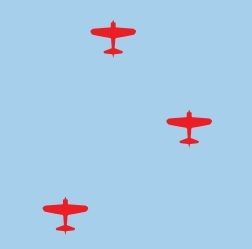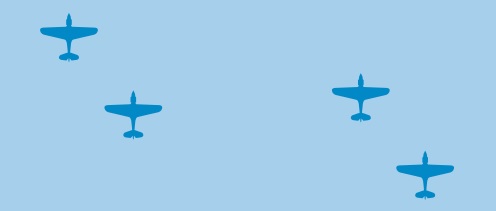An Allied fighter pilot who managed to get an A6M in his gunsight would typically find himself quickly targeted by the remaining two members of the shotai.
Imperial Japanese Naval Air Force (IJNAF) A6M Zero-sens employed the three-aircraft shotai (tactical formation) during World War II in the Pacific, which was organized in an echeloned V formation as depicted in the following image.

Although the three-aircraft shotai was an antiquated formation by European standards, the Japanese naval aviators made it highly functional by virtue of their exceptional teamwork and keen situational awareness, as explained by Peter Ingman in his book P-40E Warhawk Vs A6M2 Zero-sen East Indies and Darwin 1942. Typically flying without communications, pilots were very aware of the positions and combat circumstances of the other two shotai members.
When combined with the exceptional maneuverability of the Zero-sen, these tactics proved formidable for any adversary during the early stages of the Pacific War. The brief engagement between IJNAF A6M2 Zero-sen and USAAF P-40E Warhawks on February 20, 1942, demonstrated how fast the remaining two shotai would attack an Allied fighter pilot who was able to get an A6M in his gunsight.
Japanese troops had landed on Bali and Timor on that day, cutting off the air route between Darwin and Java and isolating the latter. IJN vessels off Bali supporting the invasion were a great target for American aircraft flying over Java, so seven A-24 Banshee dive-bombers from the 91st BS launched with a powerful escort of 16 P-40Es from the 17th PS (Prov).
When the formation was approaching the target at 14,000 feet and just as the final three A-24 pilots started to push over in their dives, Zero-sens of the 3rd Kokutai bounced it from above. Although none of the A-24s were shot down by the Zero-sens in the ensuing battle, four P-40E aircraft were lost (and a fifth was so badly shot up that it crashed back at Ngoro), and Capt. Charles Sprague, the CO of the 17th PS (Prov), was killed.
In contrast, US fighter pilots employed four-aircraft flights of two pairs during the early Pacific War (as shown in the image below).

The group’s original strategy was to climb as quickly as they could in the direction of the bombers. However, it was discovered that using “dive and zoom” strategies gave the heavier US fighters a noticeable speed advantage against the lightweight Zero-sens when diving. These updated strategies, when executed properly, effectively countered the Zero-sens sen’s agility.
P-40E Warhawk Vs A6M2 Zero-sen East Indies and Darwin 1942 is published by Osprey Publishing and is available to order here.
Photo by Osprey Publishing and Kogo via Wikipedia

